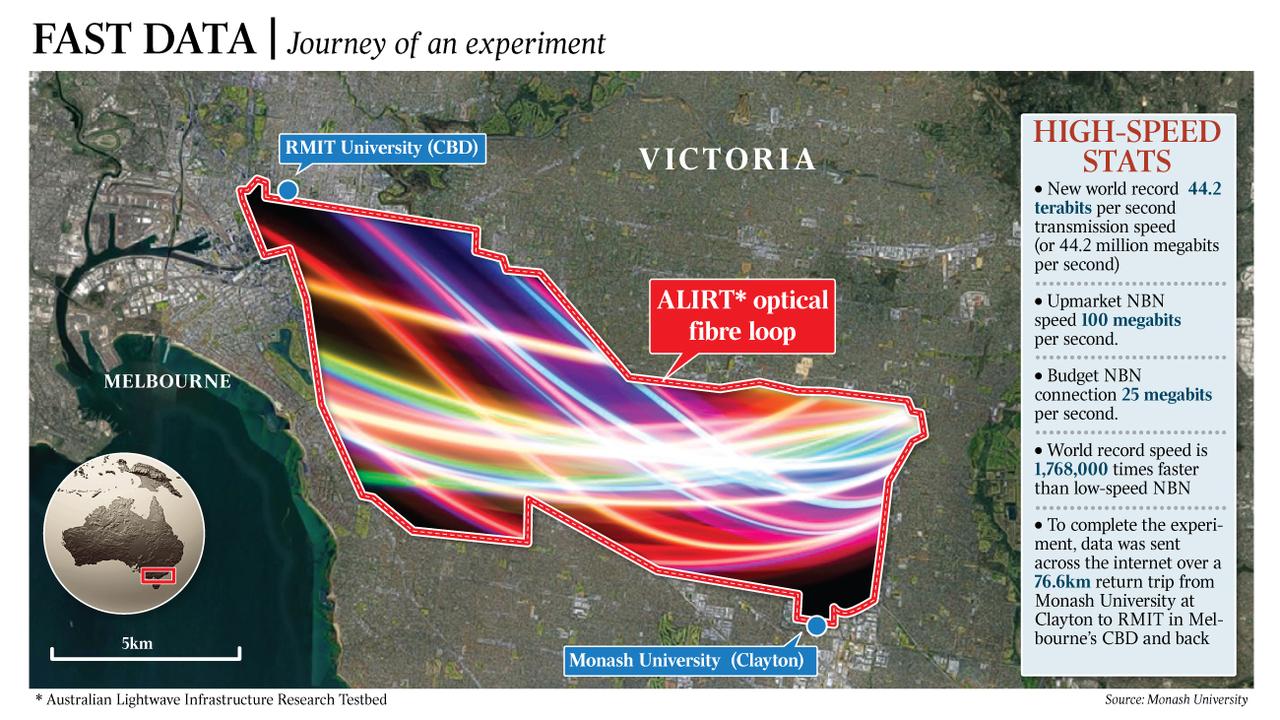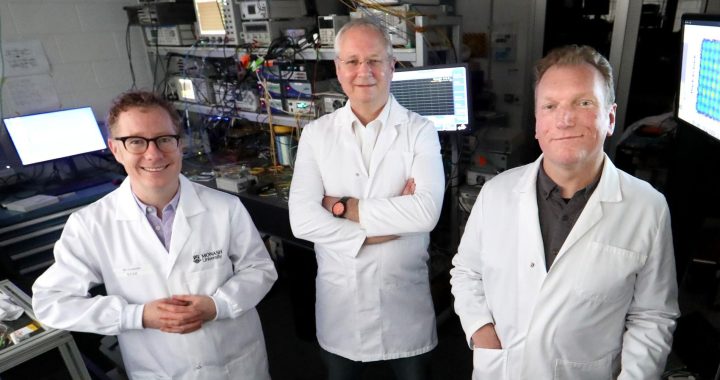They knew it would be fast. They didn’t know it would be that fast. But there it was: a record-smashing, potentially world-changing internet speed — and it had been achieved over some pretty average fibre cables stretched 76.7km between two Melbourne universities in an experiment conducted by three intrepid Australian computer scientists.
The results of the high-speed internet test, completed in February, were finally published last week to global acclaim.
“Fast enough to download 1000 HD movies in a split second!” the headlines declared.
In technical terms, that’s a mind-blowing 44.2 terabits per second transmission speed — or 44.2 million megabits per second, astronomically faster than the up-market NBN speed of 100 megabits per second.
The brains behind this cross-institutional experiment to take the speed of fibre backbone to the limit were long-time collaborators Bill Corcoran, lecturer in electrical and computer systems at Monash University, professor David Moss, a nanophotonics researcher at the Swinburne University of Technology, and RMIT professor Arnan Mitchell.
“With every experiment we do, we push the envelope as hard as we can,” Corcoran tells The Australian, explaining that while the three believed they’d see faster internet, they didn’t realise just how fast it would be.
“I’d been hunting around for something that would allow me to do this type of super-fast experiment. It just turned out when we tried doing it, it was better than we thought.”
When many Australians, especially in rural and regional areas, struggle to get a few simple megabits per second download, an internet 1.768 million times faster than a budget NBN connection of 25 megabits per second seems like a prospect from another universe.
The key to the breakthrough was the radical use of a device known as a micro-comb — a hot topic within the field of photonics — which teases laser light into dozens of strands, like when you comb your hair.

Typical uses of micro-combs span astronomy and measuring distances to exoplanets in outer space, spectroscopy (in optical clocks) and more. But over a beer during a photonics workshop in Denmark two years ago, Corcoran and Moss hatched a plan to do something different, inspired by the work of one of Moss’s students — namely, apply micro-combs to optical fibre internet.
If you could turn optical fibre into an 80-lane highway, with data speeding down each of the highway lanes, could you make optical fibre internet perform beyond our wildest expectations?
Back in Australia, Corcoran turned up at RMIT with his equipment brought across from Monash and the work began. With Mitchell on board, Australian Research Network AARNet gave them access to their fibre network for testing.
The plan was to send data 76.6km across the internet between Monash University in Clayton, in Melbourne’s outer-southeast suburbs, and RMIT in Melbourne’s CBD and back again. The results have been hailed as a breakthrough at a time when household internet speeds and connections face unprecedented tests from a large work-from-home labour force.
So what does it all mean?
The race for faster internet had been somewhat scorned of late. In August last year, The Wall Street Journal published a piece titled The Truth About Faster Internet: It’s Not Worth It, which showed that typical US households didn’t use most of their bandwidth.
But the Australian scientists’ hope is that the internet will not only be faster, but cheaper as a result of their work. With Australian internet usage growing at 25 per cent per year, we need to increase our capacity, Corcoran says.
And according to Moss, the NBN should be able to make use of the micro-comb system. He says the fibre capacity of this system is “almost unlimited”, with just a single cable capable of carrying internet traffic between Sydney and Melbourne.
A huge part of the achievement was that, whereas such feats are usually produced in pristine laboratory conditions, the experiment took place in the real world.
Corcoran says that the fibre made available by research network provider AARNet was “slightly aged” — and that it’s “the same type of fibre we’ve got in the ground around the world right now; the same type of fibre that’s been installed for the NBN”.
Which means the test results are arguably transferable to existing fibre backbone of good quality anywhere.
Corcoran believes that, if applied commercially, the micro-combs system should reduce the cost of internet access to the public and the cost and complexity of building fibre internet infrastructure. It would also vastly improve the high-speed internet connections of households locally, and billions across the world during peak usage periods.
This is welcome news in a new world where we are consuming more internet at home via everything from Zoom calls to streaming the latest feature films that have been prevented from showing in the cinema due to the coronavirus restrictions.
Moss says the team’s experiment should translate to reduced internet costs to consumers. The bigger bandwidth could be used to carry much more data, rather than just increase speed.
“We hope that allows service providers to expand their capacity. We’re hoping that you get more gigabits per second for your dollar,” he says.
Faster data communications could also enhance the operation of self-driving cars and other future transportation and help medicine, education, finance and e-commerce industries.
Without question, the Australian scientists were standing on the shoulders of giants. Despite its small population, Australia has been a trailblazer in internet digital development.
Australian engineer John O’Sullivan and his team at the CSIRO are credited with the invention of Wi-Fi in the early 1990s.

The CSIRO eventually collected more than $430m in royalties from the invention, but it had to do this the hard way, legally taking on companies such as AT&T, T-Mobile, Lenovo, Broadcom and a host of others.
Australia has also played a major role in many breakthrough technology-related inventions, such as a version of the black box flight recorder which records both voice and instruments, the pacemaker, cochlear implant and ultrasound.
Now that the micro-combs exist as chips, Corcoran says the next step will be to put the modulators that allow the laser light strands to carry data onto chips as well.
“Monash and RMIT are already collaborating on a project towards that technology.” He says this involves splitting the output from one laser source and running it through a bunch of modulators.
Corcoran says this set-up will replace “rack and racks of equipment with something that’s going to be quite small”.
So could Australia start pumping out micro-combs on a factory assembly line? Could it be a project that helps build our reputation as a hi-tech manufacturing country in the post COVID-19 era?
It’s a promising idea, but there is already a lot of competition around the world.
“The field for micro-combs has been advancing really, really fast,” Corcoran says. “There are some stellar research groups around the world, including our international collaborators, that have been working on this technology and moving it closer and closer and closer towards where you can start thinking about putting this on a CMOS production line.” (CMOS is a major technology for producing microchips.)
He predicts that if we did become a manufacturing base there would be many applications for Australian-made micro-combs, such as virus sensing, quantum information technologies, and searching for exoplanets through a telescope.
Australian researchers have been wanting to build up the infrastructure that would allow the country to develop a photonic chip manufacturing capability for several years and RMIT has the capability to build micro-comb chips for researchers. But the issue is commercialisation.
“There’s definitely scope to be able to produce these sort of technologies in Australia,” Corcoran says. “You would need investment in production line equipment, but what we have is prototyping equipment that’s there.”
He says the technology exists overseas to commercially manufacture the chips, and Australia should develop the capacity: “This is the kind of thing I feel passionately about, that we as a country should be thinking about this.”
Published in The Australian newspaper.
